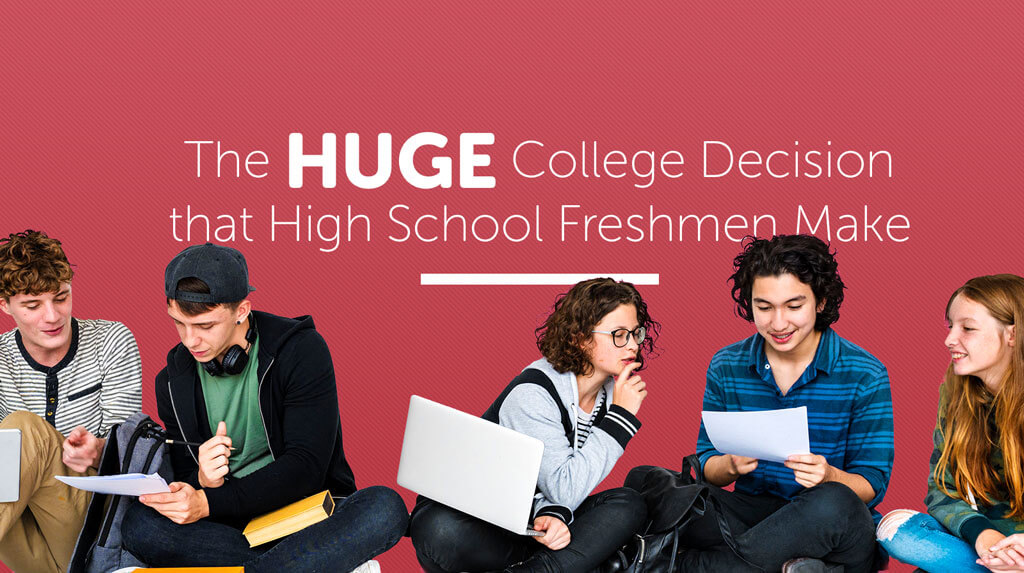Big enrollment decisions for young students
Gen Z is set to be the largest college-going generation ever, and these digital natives are changing enrollment management strategies at institutions around the country. Astonishingly, studies show that most high school students make their first-choice college decision by the end of ninth grade. While these decisions are rarely final, savvy fourteen-year-old students across the nation are already considering their college options.
The researchers who analyzed high school students’ college aspirations found that those who don’t express a preference for a particular school during freshman year may not consider themselves college-bound at all. This impacts their ultimate college pathway. Don Hossler, Jack Schmitt, and Nick Vesper found that the later students developed college aspirations or applied to schools, the less likely they were to matriculate. Those who did were more likely to enroll at a community college.
Reaching the college-bound and the late-bloomers
From the perspective of community colleges, reaching both types of students is critical to a successful enrollment management strategy. By far the most affordable and convenient choice for many freshmen, community colleges also offer an incredibly high-quality education. As higher education becomes less and less accessible, community colleges have a chance to woo new students in every demographic.
As a result, a good enrollment management strategy should speak to high school students who are already college-bound and those who don’t yet picture themselves getting a degree. Putting together this sort of campaign is easier said than done, but there are some strategies that consistently yield results. There are at least three things that every admissions office can do right now to reach prospective Gen Z students.
Pay attention to the sophomore surge
High school freshmen will say they want to attend a particular college or university, but, since these aren’t firm decisions, they are unlikely to do anything concrete to follow up (Perna, 2006). This means they won’t yet visit a campus, or even browse the school’s website. However, by sophomore year, high school students begin to actively seek out information about the colleges they would like to attend. They can even describe what they want from a school in detail (Hossler & Park).
Colleges that proactively contact sophomores during this period have a significant advantage. According to EAB, students who are contacted as sophomores are nearly twice as likely to enroll as students who are contacted as seniors. Reaching students earlier in the process has real results later on, whether or not the high school students contacted initially considered themselves college-bound.
Speak to parents as well as prospective students
Michael Galindo notes that 30% of college-bound students want their parents to be more involved in the college selection process. Moreover, although Galindo acknowledges that the stereotypical helicopter parent is an affluent white person, students across all demographics are becoming more reliant on parental advice. This includes students from low-income households.
Parents have a huge impact on college selection and increasingly want to be involved. Because of their influence on college choice, it’s important to contact prospective student parents early in the recruitment process. Still, Galindo cautions that admissions officers should ultimately prioritize their relationship with the prospective student. By working directly with the students, an admissions officer prepares them for the independence they will have to assume during college.
Cost will count (eventually)
In the earliest stages of the college search, students may not be using cost to refine their school choices. However, during senior year, students who intend to go to college will usually complete the FAFSA. This determines their eligibility for various sorts of need-based aid, and often leads them to re-evaluate their initial school preferences (Hossler & Park). Completing the FAFSA is also a strong indicator that the student will probably enroll in college (Roderick et al. 2008).
Since parents and students alike are increasingly concerned by the mounting costs of college, the impact of the FAFSA on college choice cannot be overstated. Still, community colleges should never present themselves only as the budget option for education. Although affordability becomes more important during senior year, colleges should establish a relationship with prospective students long before this point.
Consistent contact throughout high school is key
High school students are more likely than ever to be thinking about college, freshmen through senior year. In some ways, this gives colleges and universities a golden opportunity to execute an enrollment management strategy. By presenting prospective students with engaging, helpful, and consistent information about the college experience, schools can earn a spot on their final list. Consistent contact with Gen Z now will pay dividends in the future.
References
Hossler, D., Park, E. “Understanding Student College Choice.” ed. Don Hossler and Bob Bontrager. Handbook of Strategic Enrollment Management. vol. first edition, San Francisco, CA: Jossey-Bass, 49-76
Hossler, D., Schmitt, J., & Vesper, N. (1999). Going to College: How Social, Economic, and Educational Factors Influence the Decisions Students Make. Baltimore, MD: The Johns Hopkins University Press.
Perna, L. W. (2004). “Differences in the decision to attend college among African Americans, Hispanics, and Whites.” The Journal of Higher Education, 71(2), 117-141
Roderick, M., Nagoaka, J., Coca, V., Moeller, E., Roddie, K., Gilliam, J., & Patton, D. (2008) From High Schools to the Future: Potholes on the Road to College. Chicago: Consortium on Chicago School Research at the University of Chicago


